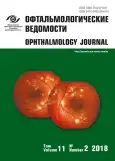Analysis of long-term results of collagen corneal cross-linking in patients with ectatic forms of corneal dystrophy
- Authors: Frolov O.A.1, Astakhov S.Y.2, Danilov P.A.2, Novikov S.A.2
-
Affiliations:
- Diagnostic Center No 7 (Eye) for Adults and Children
- Academician I.P. Pavlov First St. Petersburg State Medical University of the Ministry of Healthcare of Russia
- Issue: Vol 11, No 2 (2018)
- Pages: 6-12
- Section: Articles
- URL: https://journals.rcsi.science/ov/article/view/8931
- DOI: https://doi.org/10.17816/OV1126-12
- ID: 8931
Cite item
Abstract
Corneal collagen cross-linking became a permanent part of complex treatment for patients with different forms of corneal ectasia. In periodical literature, there are anecdotal reports concerning long-term results of this corneal disease therapy method, which is an isolated variant of photodynamic therapy.
Purpose. To carry out a retrospective study of corneal collagen cross-linking long-term results in various ectatic corneal diseases.
Materials and methods. Results of corneal collagen cross-linking in patients with ectatic forms of corneal dystrophy 6 years after surgery were analyzed. The nosological structure of the study included a group of patients with primary keratoconus, pellucid marginal corneal degeneration, secondary ectasias. The group with primary keratoconus includes 30 patients (31 eyes), that with pellucid marginal degeneration 10 patients (10 eyes), that with secondary ectasias – 10 patients (10 eyes). Data of the diagnostic examination before surgery, intermediate data of the dynamic follow-up during 6 years of observation were used for the analysis. Corneal collagen cross-linking was performed in the first or second year of follow-up, followed by monitoring of changes in the state of the cornea after corneal collagen cross-linking for 4-5 years.
Results. A statistically significant increase in visual acuity was observed after the corneal collagen cross-linking in patients with primary and secondary ectasias. In patients diagnosed with pellucid marginal degeneration, there was no statistically significant increase of visual function. A decrease in the corneal asymmetry index was revealed in all groups and confirmed by statistical analysis.
Full Text
##article.viewOnOriginalSite##About the authors
Oleg A. Frolov
Diagnostic Center No 7 (Eye) for Adults and Children
Author for correspondence.
Email: oleg524@mail.ru
Head of the Department of Complex Optical Correction
Russian Federation, Saint PetersburgSergey Yu. Astakhov
Academician I.P. Pavlov First St. Petersburg State Medical University of the Ministry of Healthcare of Russia
Email: astakhov73@mail.ru
MD, PhD, DMedSc, professor, head of Ophthalmology Department
Russian Federation, Saint PetersburgPavel A. Danilov
Academician I.P. Pavlov First St. Petersburg State Medical University of the Ministry of Healthcare of Russia
Email: pdanilov1989@gmail.com
Post-Graduate Student, Department of Ophthalmology with the Clinic
Russian Federation, Saint PetersburgSergey A. Novikov
Academician I.P. Pavlov First St. Petersburg State Medical University of the Ministry of Healthcare of Russia
Email: serg2705@yandex.ru
MD, PhD, DMedSc, professor, Ophthalmology Department
Russian Federation, Saint PetersburgReferences
- Новиков C.А., Кольцов А.А., Данилов П.А., Федотова К. К вопросу о стандартизации и оптимизации офтальмологического обследования пациентов // Современная оптометрия. – 2016. – № 10. – С. 30–49. [Novikov SA, Koltsov AA, Danilov PA, Fedotova K. Aboutstandardization and optimization of vision examination procedure. Actual Optometry. 2016;(10):30-49. (In Russ.)]
- Папанян С.С., Новиков С.А., Саакян А.C., Фролов О.А. Результаты ретроспективного исследования коллагенового кросслинкинга при кератоконусе на ранних стадиях заболевания // Современная оптометрия. – 2015. – № 10 (90). – С. 20–24. [Papanyan SS, Novikov SA, Saakyan AS, Frolov OA. The results of retrospective studies of cross-linking for keratoconusnin the early stages. Actual Optometry. 2015;(10(90)):20-24. (In Russ.)]
- Andreassen TT, Simonsen AH, Oxlund H. Biomechanical properties of keratoconus and normal corneas. Exp Eye Res. 1980;31(4):435-441.
- Angunawela RI, Arnalich-Montiel F, Allan BD. Peripheral sterile corneal infiltrates and melting after collagen crosslinking for keratoconus. J Cataract Refract Surg. 2009;35(3):606-607. doi: 10.1016/j.jcrs.2008.11.050.
- Bykhovskaya Y, Li X, Epifantseva I, Haritunians T, et al. Variation in the lysyl oxidase (LOX) gene is associated with keratoconus in family-based and case-control studies. Invest Ophthalmol Vis Sci. 2012;53(7):4152-4157. doi: 10.1167/iovs.11-9268.
- Daxer A, Misof K, Grabner B, et al. Collagen fibrils in the human corneal stroma: structure and aging. Invest Ophthalmol Vis Sci. 1998;39(3):644-648.
- Duan X, McLaughlin C, Griffith M, et al. Biofunctionalization of collagen for improved biological response: scaffolds for corneal tissue engineering. Biomaterials. 2007;28(1):78-88. doi: 10.1016/j.biomaterials.2006.08.034.
- Ghanem VC, Ghanem RC, de Oliveira R. Postoperative pain after corneal collagen crosslinking. Cornea. 2013;32(1):20-24. doi: 10.1097/ICO.0b013e31824d6fe3.
- Kamaev P, Friedman MD, Sherr E, et al. Photochemical kinetics of corneal cross-linking with riboflavin. Invest Ophthalmol Vis Sci. 2012;53(4):2360-2367. doi: 10.1167/iovs.11-9385.
- Koller T, Mrochen M, Seiler T. Complication and failure rates after corneal crosslinking. J Cataract Refract Surg. 2009;35(8):1358-62. doi: 10.1016/j.jcrs.2009.03.035.
- Kopsachilis N, Tsaousis KT, Tsinopoulos IT, et al. A novel mechanism of UV-A and riboflavin-mediated corneal cross-linking through induction of tissue transglutaminases. Cornea. 2013;32(7):1034-1039. doi: 10.1097/ICO.0b013e31828a760d.
- Pollhammer M, Cursiefen C. Bacterial keratitis early after corneal crosslinking with riboflavin and ultraviolet-A. J Cataract Refract Surg. 2009;35(3):588-589. doi: 10.1016/j.jcrs.2008.09.029.
- Rabinowitz YS. Keratoconus. Surv Ophthalmol. 1998;42(4):
- -319.
- Raiskup F, Hoyer A, Spoerl E. Permanent corneal haze after riboflavin-UVA – induced cross-linking in keratoconus. J Refract Surg. 2009;25(9):S824-S828. doi: 10.3928/1081597X-
- -12.
- Raiskup-Wolf F, Hoyer A, Spoerl E, et al. Collagen crosslinking with riboflavin and ultraviolet-A light in keratoconus: long-term results. J Cataract Refract Surg. 2008;34(5):796-801. doi: 10.1016/j.jcrs.2007.12.039.
- Saad A, Lteif Y, Azan E, et al. Biomechanical properties of keratoconus suspect eyes. Invest Ophthalmol Vis Sci. 2010;51(6):2912-6. doi: 10.1167/iovs.09-4304.
- Sady C, Khosrof S, Nagaraj R. Advanced Maillard reaction and crosslinking of corneal collagen in diabetes. Biochem Biophys Res Commun. 1995;214(3):793-797. doi: 10.1006/bbrc.1995.2356.
- Spoerl E, Huhle M, Seiler T. Induction of crosslinks in corneal tissue. Exp Eye Res. 1998;66(1):97-103.
- Tomkins O, Garzozi HJ. Collagen cross-linking: Strengthening the unstable cornea. Clin Ophthalmol. 2008;2(4):863-867.
- Wollensak G. Crosslinking treatment of progressive keratoconus: new hope. Curr Opin Ophthalmol. 2006;17(4):356-360. doi: 10.1097/01.icu.0000233954.86723.25.
- Wollensak G, Spoerl E, Seiler T. Riboflavin/ultraviolet-a-induced collagen crosslinking for the treatment of keratoconus. Am J Ophthalmol. 2003;135(5):620-627.
- Zhang Y, Conrad AH, Conrad GW. Effects of ultraviolet-A and riboflavin on the interaction of collagen and proteoglycans during corneal cross-linking. J Biol Chem. 2011;286(15):13011-13022. doi: 10.1074/jbc.M110.169813.
Supplementary files










